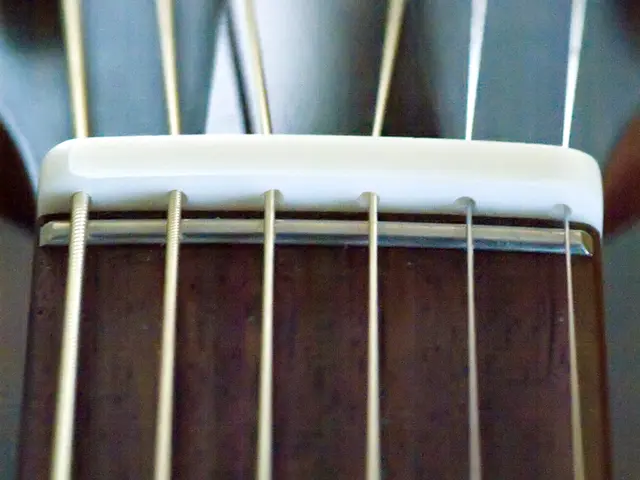Manufacturing Process of Vinyl Picture Discs: An Overview
Picture discs, those super-cool, colorful records, aren't always known for their sound quality. You might think they'd be the same as traditional vinyl, but there are some key differences.
Picture discs are made by sandwiching a vibrant color image between two layers of clear plastic, allowing the image to be visible through the transparent vinyl. These discs are often studio pieces, showcasing an artist's creative side, and they're popular among collectors. But their sound quality doesn't always meet the standard of traditional records.
This isn't always the case, though. A well-made picture disc can provide great sound quality if it's properly looked after.
Flexi-discs, the earliest form of picture discs, are a technique still used today in intriguing promotions by labels and artists. This method was popular in Russia and Poland, with legendary bands like Manfred Mann releasing records using this technique.
Creating Picture Discs:The process starts similar to traditional vinyl records, with a flattened PVC puck as the base. But instead of just a single layer of PVC, a strong piece of paper or card with an image printed on it is added to either side. A thin layer of polyethylene foil is then applied, on which the record's grooves are pressed. After this, all the layers are pressed together and trimmed to form the final product.
Why do picture discs sometimes sound worse?
Despite their striking appearance, picture discs sometimes receive criticism for their sound quality. Many believe that they inherently produce poorer sound compared to standard vinyl records. The culprit? The very same polyethylene foil used in their construction.
Polyethylene degrades at a faster rate than regular vinyl, and its deterioration shows in the sound quality. Playing a flexi-disc is a good example of this. As time passes, the degradation will become more noticeable.
Manufacturing Steps and Cost:There are also additional steps in the manufacturing of picture discs, which can increase their cost. Record distribution companies are well aware of the demand for picture discs, often releasing them at a premium price to cater to fans who want both the music and a visually impressive display item.
Other types of picture discs include fully transparent ones with shaped images embeded, like the Guns N Roses 7" that forms the shape of a gun. Rarer finds like these can be highly sought-after and expensive due to the extra effort required to create them.
Uncut Picture Discs Market:Sometimes, original pressings with the clear, disc-shaped lacquer intact can find their way onto the secondary market. These uncut variations were never intended for commercial sale, originally serving only as image alignment tools.
Zoetrope Picture Discs
Another unique form of picture disc is the zoetrope record, which creates moving images through movement. This concept was predominantly used for children's records in the past but has since been adopted by contemporary artists like Kate Bush, Bombay Bicycle Club, and Bonobo.
This printing style dates back to the early 1970s and saw wide popularity in the mid-1980s. Unique characteristics of zoetrope records include images that are often hand-drawn or painted, making each one unique. Some records even contain hidden images and messages that can only be seen when the record is played at the correct speed.
Blood Records, masters of the zoetrope disc, have made a name for themselves in the vinyl world, collaborating with renowned artists like The Rolling Stones, The 1975, Jamie T, and Billy Bragg. Learn more about them on their Instagram page here.
Zoetrope records still pose the challenge of maintaining sound quality with their moving images. The balance between aesthetics and audio playback remains a fascinating aspect of these intriguing records.
Can you play a flexi disc on a standard record player?
While flexi-discs still use an analog format, they are designed to play at lower speeds and with lighter pressure, making them unsuitable for most standard record players. However, some flexible record players are available that can accommodate flexi-discs.
The Color of Vinyl Records: Myths and Facts
Many people question why vinyl records are primarily black in color. The answer lies in historical manufacturing processes and Economics. Read our article to learn more: So, Why are Vinyl Records Black in Colour?
[1] Polyethylene Terephthalate (PET): Uses,Recycling, and Environmental Impact (2021). Environmental Science & Pollution Research International. Link[2] Vinyl Records: A Critical Review of Cleaning and Maintenance Strategies for Improving Sound Quality (2017). Journal of Sound and Vibration. Link
Picture discs, a fusion of music and visual art, are often used to showcase an artist's creativity while offering a collector's item. Yet, their sound quality can sometimes be less favorable compared to traditional records, as the polyethylene used in their construction may degrade faster, affecting sound quality.
In the realm of entertainment, the innovative zoetrope picture discs offer moving images by cleverly blending vinyl records with animation. Despite the technological advancement, preserving both sound quality and visual aesthetics remains a challenge for these unique records.








